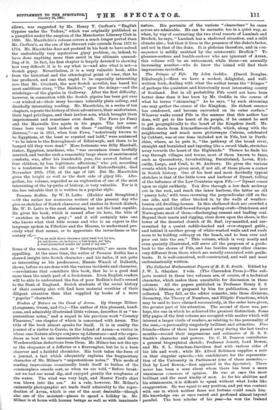The Fringes of Fife. By John Geddie. (David Douglas, Edinburgh.)—Here
we have a modest, delightful, and well- written book, dealing with what the author terms the " fringes "
of perhaps the quaintest and historically most interesting county of Scotland. But in all probability Fife could not have been better done than it has been by Mr. Geddie in the course of what he terms " skimming." As he says, " by such skimming one may gather the cream of the Kingdom. Its richest essence
has condensed, and become encrusted on its outer surface." Whoever walks round Fife in the manner that this author has done, will get to the heart of its people, if he cannot be said to get geographically to the heart of the Kingdom itself. Mr. Geddie starts from Kincardine-on-Forth, which, along with the neighbouring and much more picturesque Culross, celebrated by Cobbett, was at one time included not in Fife, but in Perth- shire, where, as he puts it, "the pathway of the broad river, straight and burnished and tapering like a sword blade, stretches away towards the heart of the Highlands." Thence he finds his way through villages and towns, most of them known to fame, such as Queensferry, Inverkeithing, Burntisland, Leven, Kirk- caldy, Largo, and Crail, to St. Andrews. He gives the various events which have given most, if not all, of these places a corner in Scotch history. One of his best and most decidedly typical sketches is that of the little town and harbour of Dysart, telling of the influence of the Low Countries upon Fife :—" Dysart comes upon us right suddenly. You dive through a low dark archway cut in the rock, and reach the inner harbour, the latter an old quarry hole,' with trees crowning the perpendicular cliff on the one side, and the other blocked in by the walls of weather- beaten old dwelling-houses. In this sheltered dock are crowded a dozen squat and bluff-bowed foreign sailing-craft—Dutchmen and Norwegians most of them—discharging cement and loading coal. Beyond their masts and rigging, close down upon the shore, is the tower of the deserted church of St. Serf, ivy-mantled, and sur- mounted by a quaint saddle-backed and crow-stepped gable ; and behind it another group of white-washed walls and red roofs seem to be holding colloquy on the beach, and to lean over and peer out into the sea." This volume, which is very neatly and even quaintly illustrated, will serve all the purposes of a guide- book to the shores of Fife, and has besides many other charms very different from those which are usually associated with guide- books. It is well-conceived, well-constructed, and well and most enthusiastically written.


















































 Previous page
Previous page